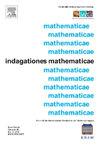A construction of solutions of an integrable deformation of a commutative Lie algebra of skew hermitian Z×Z-matrices
IF 0.5
4区 数学
Q3 MATHEMATICS
引用次数: 0
Abstract
Inside the algebra of -matrices with coefficients from a commutative -algebra that have only a finite number of nonzero diagonals above the central diagonal, we consider a deformation of a commutative Lie algebra of finite band skew hermitian matrices that is different from the Lie subalgebras that were deformed at the discrete KP hierarchy and its strict version. The evolution equations that the deformed generators of have to satisfy are determined by the decomposition of in the direct sum of an algebra of lower triangular matrices and the finite band skew hermitian matrices. This yields then the -hierarchy. We show that the projections of a solution satisfy zero curvature relations and that it suffices to solve an associated Cauchy problem. Solutions of this type can be obtained by finding appropriate vectors in the -module of oscillating matrices, the so-called wave matrices, that satisfy a set of equations in the oscillating matrices, called the linearization of the -hierarchy. Finally, a Hilbert Lie group will be introduced from which wave matrices for the -hierarchy are constructed. There is a real analogue of the -hierarchy called the -hierarchy. It consists of a deformation of a commutative Lie algebra of anti-symmetric matrices. We will properly introduce it here too on the way and mention everywhere the corresponding result for this hierarchy, but we leave its proofs mostly to the reader.
倾斜[式略]-赫米特矩阵的交换李代数可积分变形解的构造
在中央对角线以上只有有限个非零对角线的换元-矩阵代数中,我们考虑了有限带偏赫米矩阵的换元Lie代数的变形,它不同于在离散KP层次上变形的Lie子代数及其严格版本。变形生成器必须满足的演化方程是由下三角矩阵代数和有限带偏斜羿米提矩阵的直接和的分解决定的。这就产生了-层次结构。我们证明,解的投影满足零曲率关系,只需求解相关的考希问题即可。这种类型的解可以通过在振荡矩阵的-模块(即所谓的波矩阵)中找到适当的向量来获得,这些向量满足振荡矩阵中的方程组,即-层次结构的线性化。最后,将引入一个希尔伯特李群,并从中构造出-层次结构的波矩阵。-层次结构有一个实数类似物,称为-层次结构。它由反对称矩阵的交换李代数的变形组成。我们在这里也将顺便适当介绍它,并随处提及这种层次结构的相应结果,但我们将其证明主要留给读者。
本文章由计算机程序翻译,如有差异,请以英文原文为准。
求助全文
约1分钟内获得全文
求助全文
来源期刊
CiteScore
1.20
自引率
16.70%
发文量
74
审稿时长
79 days
期刊介绍:
Indagationes Mathematicae is a peer-reviewed international journal for the Mathematical Sciences of the Royal Dutch Mathematical Society. The journal aims at the publication of original mathematical research papers of high quality and of interest to a large segment of the mathematics community. The journal also welcomes the submission of review papers of high quality.

 求助内容:
求助内容: 应助结果提醒方式:
应助结果提醒方式:


